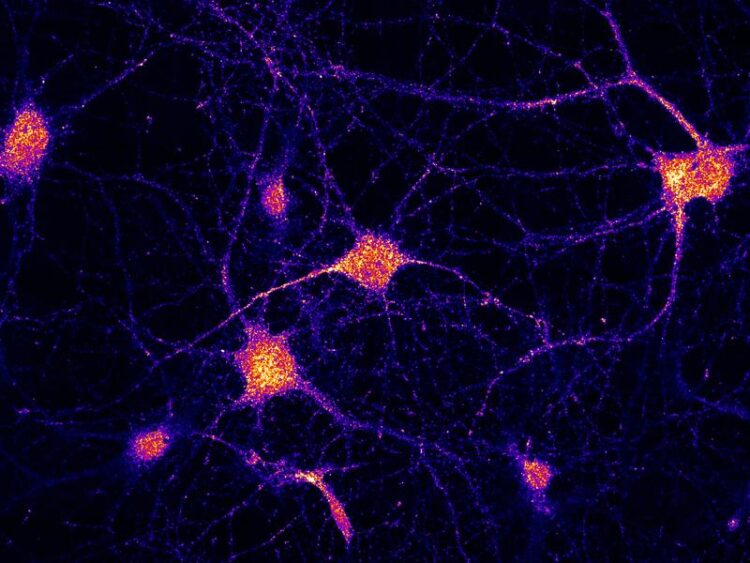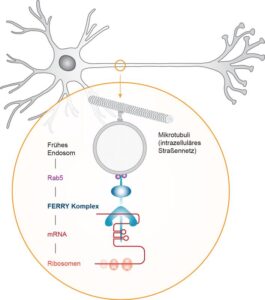Brain Logistics

Localization of the FERRY complex in neurons.
(c) Schumacher et al. (2023) / MPI-CBG
Missing link explains mRNA delivery in brain cells.
Teams from MPI Institutes in Dresden, Dortmund, Frankfurt am Main and Göttingen have joined forces to gain the first evidence of a protein complex responsible for the transport of messenger RNA in neurons.

(c) Schumacher et al. (2023) / MPI-CBG
Brain cells manufacture proteins in every corner, including their long branches. Neurons missing this ability cause severe neurological disorders like disability and epilepsy. The groups of Marino Zerial, Max Planck Institute (MPI) of Molecular Cell Biology and Genetics in Dresden, and Stefan Raunser, MPI of Molecular Physiology in Dortmund, together with colleagues from the MPI for Brain Research in Frankfurt am Main and the MPI for Biophysical Chemistry in Göttingen have discovered a new delivery mechanism that brings messenger RNA (mRNA), the proteins’ blueprint, to the point of need in neurons. Using an array of techniques, the researchers have identified a protein complex, named FERRY, which links mRNA to intra-cellular carriers, and elucidated its role and structure. The discovery may lead to a better understanding of neurological disorders caused by FERRY malfunction and possibly to new medical targets. The results are detailed in two recent works, published back-to-back in the journal Molecular Cell.
Faraway, so close!
“These publications provide a major advancement to elucidate the mechanisms underlying mRNA distribution in brain cells,” Marino Zerial says. Cells produce vital proteins using mRNA as a blueprint and ribosomes as 3D printers. Yet, brain cells have a logistic challenge to overcome: A tree-like shape with branches that can span centimeters in the brain. “This implies that thousands of mRNAs need to be transported far away from the nucleus, resembling the logistic effort of properly supplying supermarkets in an entire country,” Jan Schuhmacher says, first author of the study.
So far, researchers attributed the carrier role to spherical compartments inside the cell, called Late Endosomes. However, MPI scientists argue that a different form of the compartments, called Early Endosomes (EEs), are also suitable as mRNA carriers, due to their ability to travel in both directions along intracellular road networks. In the first publication, led by Marino Zerial from MPI in Dresden, scientists discovered the function of a protein complex that they called FERRY (Five-subunit Endosomal Rab5 and RNA/ribosome intermediarY). In neurons, FERRY is linked to EEs and works similarly to a tie-down strap during transport: It interacts directly with mRNA and holds it onto EEs, which hence become logistic carriers for mRNA transport and distribution in brain cells.
Complex details
But how does FERRY bind to mRNA? That’s when Stefan Raunser’s group from the MPI Dortmund comes into play. In the second publication, Dennis Quentin et al. used cryo-electron microscopy (cryo-EM) to infer the structure of FERRY and the molecular features that allow the complex to bind to both EEs and mRNAs. The new 3D atomic model of FERRY, with a resolution of 4 Ångstroms, shows a novel mode of binding RNA, which involves coiled-coil domains. Scientists also explained how some genetic mutations affect FERRY’s ability to link mRNA thus leading to neurological disorders. “Our research sets the groundwork for a more comprehensive understanding of neurological disorders caused by a failure of mRNA transport or distribution that might also lead to the identification of therapeutically relevant targets,” Raunser says.
Wissenschaftliche Ansprechpartner:
Corresponding author
Prof. Dr. Stefan Raunser
Max Planck Institute of Molecular Physiology
Tel.: +49 231 133 2300
email: Stefan.Raunser@mpi-dortmund.mpg.de
Corresponding author
Prof. Dr. Marino Zerial
Max Planck Institute of Molecular Cell Biology and Genetics
Tel.: +49 351 210 1100
email: zerial@mpi-cbg.de
Originalpublikation:
Jan S. Schuhmacher, Susanne tom Dieck, Savvas Christoforidis, Cedric Landerer, Jimena Davila Gallesio, Lena Hersemann, Sarah Seifert, Ramona Schäfer, Angelika Giner, Agnes Toth-Petroczy, Yannis Kalaidzidis, Katherine E. Bohnsack, Markus T. Bohnsack, Erin M. Schuman, Marino Zerial: The Rab5 effector FERRY links early endosomes with mRNA localization, Molecular Cell, June 01, 2023, doi: 10.1016/j.molcel.2023.05.012
Dennis Quentin, Jan S. Schuhmacher, Björn U. Klink, Jeni Lauer, Tanvir R. Shaikh, Pim J. Huis in ’t Veld, Luisa M. Welp, Henning Urlaub, Marino Zerial, Stefan Raunser: Structural basis of mRNA binding by the human FERRY Rab5 effector complex, Molecular Cell, June 01, 2023, doi: 10.1016/j.molcel.2023.05.009
Press Contact
Katrin Boes
Max Planck Institute of Molecular Cell Biology and Genetics
Tel.: +49 351 210 2080
email: kboes(at)mpi-cbg.de
Johann Jarzombek
Max Planck Institute of Molecular Physiology
Tel.: +49 231 133 2522
email: johann.jarzombek(at)mpi-dortmund.mpg.de
All latest news from the category: Life Sciences and Chemistry
Articles and reports from the Life Sciences and chemistry area deal with applied and basic research into modern biology, chemistry and human medicine.
Valuable information can be found on a range of life sciences fields including bacteriology, biochemistry, bionics, bioinformatics, biophysics, biotechnology, genetics, geobotany, human biology, marine biology, microbiology, molecular biology, cellular biology, zoology, bioinorganic chemistry, microchemistry and environmental chemistry.
Newest articles

An Endless Loop: How Some Bacteria Evolve Along With the Seasons
The longest natural metagenome time series ever collected, with microbes, reveals a startling evolutionary pattern on repeat. A Microbial “Groundhog Year” in Lake Mendota Like Bill Murray in the movie…

Witness Groundbreaking Research on Achilles Tendon Recovery
Achilles tendon injuries are common but challenging to monitor during recovery due to the limitations of current imaging techniques. Researchers, led by Associate Professor Zeng Nan from the International Graduate…

Why Prevention Is Better Than Cure—A Novel Approach to Infectious Disease Outbreaks
Researchers have come up with a new way to identify more infectious variants of viruses or bacteria that start spreading in humans – including those causing flu, COVID, whooping cough…



